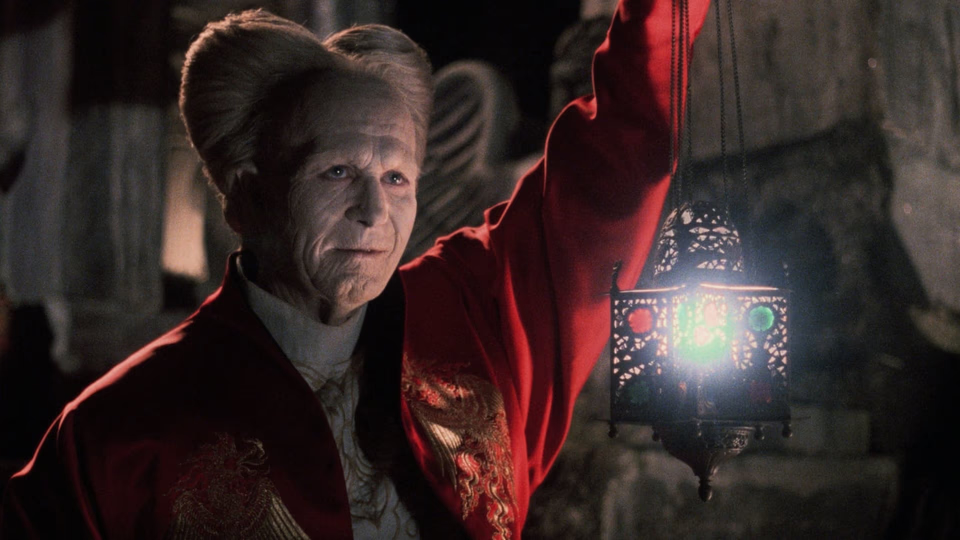Bram Stoker's Dracula

Vlad Dracula, a Christian warlord, leads his army into battle against an overwhelming Turkish Muslim force. Though he emerges victorious, the Turks send word to Vlad’s beloved wife that he has perished. She commits suicide. An outraged Vlad renounces God and curses himself to become a vampire. Four centuries later, he emigrates to London and discovers his wife’s reincarnation.
I revisited this after listening to Audible’s production of Bram Stoker’s novel. Since this adaptation bears the “Bram Stoker’s” designation, I thought it would hew truer to the source material.
I was mistaken.
While keeping the basic structure, the film reimagines Stoker’s horror as a melodramatic romance. In the book, Dracula preys on Mina as revenge against the men hunting him. In this film, he cries when he first sees her, fights the urge to bite her, weeps when she leaves him to marry Jonathan, and only turns her after she throws herself at him.
To balance this softer Dracula, the film darkens the heroes. Van Helsing careens between somber determination and manic glee. When Mina asks how Lucy died, he replies in a matter-of-fact tone, “We drove a stake through her heart and cut off her head,” and takes a bite of roast beef. Jack Seward injects himself with morphine between rounds in his dungeon-like sanatorium, Arthur Holmwood barges into rooms and barks orders at every opportunity, and Quincy blubbers like a country rube.
On the casting front, Tom Waits surprises as Renfield. Mixing equal parts pathos and menace, his take ranks alongside Dwight Fry’s performance in the Lugosi version.
Gary Oldman also shines as Dracula. His slight frame and delicate features contradict the book’s tall, aquiline Count, but they fit this version, who spends more time crying than drinking blood. Oldman’s a chameleon, capable of portraying a more aggressive, hyper-masculine presence, but he molds himself to this role. His Lugosiesque accent never creeps into mimicry and allows him to deliver lines like “I have crossed oceans of time for you,” with a straight face.
As Mina, Winona Ryder acquits herself well-enough, but struggles with some of the script’s purple prose. When she looks deep into Oldman’s eyes, begging him to turn her, saying, “Take me away from all this death,” the corniness makes me cringe.
As Van Helsing, Anthony Hopkins fares better. Like Oldman, his overdone accent makes lines like, “She’s the devil’s whore!” easier to swallow. But I couldn’t shake a sense that, despite a script that sees him teleporting across a garden and decapitating vampires with his trusty Gurkha knife, Hopkins seems bored—or at least disappointed.
As for the other heroes, true to the book, Quincy proves extraneous. As Arthur, Cary Elwes looks lost. As though he arrived to play a British nobleman and discovered the role rewritten as a Hollywood studio mogul. At least Richard Grant convinces as the drug-addled Seward.
But it’s Keanu Reeves’ casting as Jonathan Harker that almost sinks the production. His London-by-way-of-Southern-California accent and premature grey hair are laugh-out-loud preposterous. Perhaps this explains the decision to shorten the first act involving Harker’s visit to Castle Dracula.
And yet, despite these shortcomings, the film proves a joy to watch. Director Francis Ford Coppola injects every shot with formal vigor. He uses every classic cinematic tool in the toolbox. Optical overlays casting Dracula’s face in the night sky, animating Dracula as a mist seeping out of Carfax Abbey, lush matte paintings of Castle Dracula, over-and-under cranking the POV shots when Dracula takes wolf form, and even, for early shot of Dracula descending the steps, recording Oldman walking up them backwards then playing the footage in reverse to convey a sense of unease. Not to mention the terrific practical makeup effects.
When he’s not using a creative effect, Coppola ensures the frame looks sumptuous, investing in gorgeous production design, evoking the best of Hammer Films and German expressionism.
Indeed, the film proves a triumph of style over substance. It should be called Cinema’s Dracula, as Coppola steals the best formal bits of every adaptation, heightens them, and delivers a sumptuous audio-visual experience.
Imagine what he could have done with a better script.